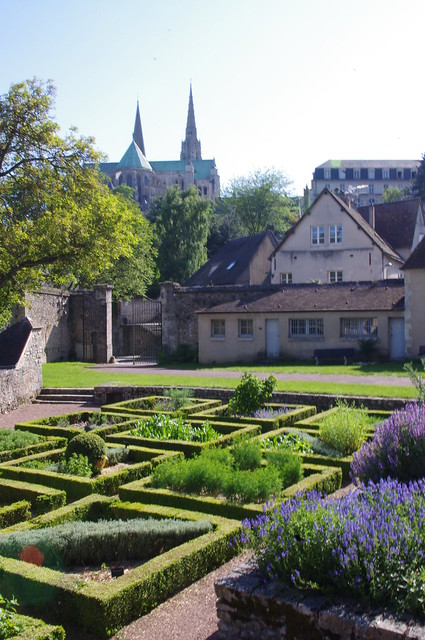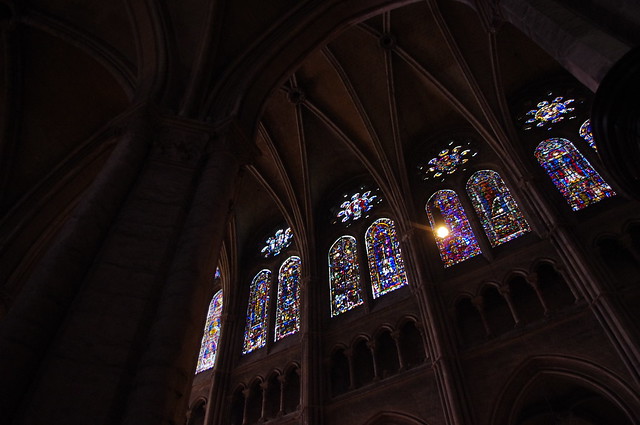I came across a rather scathing article on the restoration of the Cathedral at Chartres recently, which reads along the lines of ‘go now, before it’s too late’. In actuality, as I discovered when I visited earlier this week, it’s either too late or too early to see the building at its best, but now might be the perfect time to visit if you want to evaluate the restoration work itself.
Notre Dame de Chartres, known to many just as ‘Chartres,’ is remarkable in a number of ways. The sheer bulk of it, astounding as you arrive on the train (if you sit on the left hand side from Paris), is impressive, and the cathedral completely dominates the town. While the area’s quite built up now, one can imagine easily how spectacular it would have been, seen from a distance looming across fields, to medieval pilgrims. It’s still incredible.
Chartres is known, too, for its light and for its labyrinth. On a bright day, the glow when one steps into the dark interior is magical, particularly while the eyes are still adjusting to the change. I chose to visit on a very sunny day, but unfortunately found few places where the colours from the stained glass fell across the interior; this might be due to the angles from which the sun hits the Cathedral in the afternoon. Chartres was built to have particularly large stained glass windows; their effect has unfortunately been diminished slightly by the addition of hanging electric lights. The large labyrinth on the floor was further into the nave than I expected, but is surprisingly moving -representing the twisting path of the spiritual journey- even today.
One of the main reasons that Chartres is celebrated, though, is that the building’s interior is stylistically much more unified than many other gothic cathedrals. The majority of the Cathedral was erected quite quickly, from 1194 to 1230, after fire destroyed much of an earlier cathedral, and the speed with which it was built meant architectural fashions, technical possibilities and practical requirements didn’t change too much over the course of the project. While most buildings of Chartres’ age are an eclectic mix of styles and times, this is only really true of this cathedral’s exterior (the south tower and west portal are from the earlier church, build around 1140, and the north tower is a sixteenth century addition, to point out the most obvious disjuncture). Inside, small changes have occurred, but nothing really major.

If you’ve been inside recently, though, you may have been puzzled by the disjuncture between the nave and the bays (the narthex) which lie between the nave and the western portal. Looking at the choir, too, you may be tempted to conclude that Chartres was later enlarged and that the narthex and choir are from an entirely different period to the nave and transepts. If you look closely, you’ll realise that the primary difference is the colour.
Chartres appears as such, half light and half dark, because of the restoration in progress. Work appears to be finished on the narthex, largely finished in the choir and currently taking place in the ambulatory. It hasn’t yet begun on the nave, which for the moment is where the Chartres experience feels centered. It was discovered in 1994 that this cathedral was originally yellow, with detailing illustrating structural aspects painted white, and the dark colour that has long dominated is, in fact, age and soot.

It’s hard to fault returning Chartres to its intended, and original, state as an aim. The cathedral is celebrated internationally as a cohesive example of gothic architecture, but has been offering visitors a perception of its colour that’s largely false. In addition to historical accuracy, the new/old colours help one get a sense of the transition from gothic to renaissance architecture for its continuities alongside its breaks. While Alistair Palmer (in the article above) notes the effects of the light against the darker walls, the light bouncing off pale yellow walls will have its own beauty when completed; from some angles, there was an incredible lightness to the narthex that would be extraordinary if filling the whole space.
Nonetheless, at the moment it’s largely the parts which haven’t been restored which glow and blow one away. The areas which are already yellow and white at times appear as if a garish frame. The cathedral’s romance feels drained. Sitting alongside one another as they do, the difference is extraordinary.
The North clocktower is still open to those who want to climb it. Few others did when I was there, but I’d recommend it for several reasons. There are good views of the roof (19th century, and once the largest iron span in the world) and the buttresses of Chartres. The climb, with all its different viewpoints, offers a reminder of the cathedral’s size at a point when much of the interior is inaccessible. It also offers views of the south tower, and allows a closer look at Jehan de Beauce’s craftsmanship while the screen in the choir isn’t visible. It’s also good exercise and access to countryside air!
(It is terrifying though; it feels as if the wind is blowing through the stone and then, when you finally succeed in making it to the top, the balcony is very narrow and there's a graveyard in the distance to remind you of your peril -thanks Chartres!)
If you want to see Chartres as you saw it three years ago, you’re already too late. If you want to see the interior as a thirteenth century pilgrim saw it, you’ll have to wait a few more years. If you’re interested in restoration, though, and want to witness an important moment of transition in the cathedral’s history, now is the perfect moment to visit.


